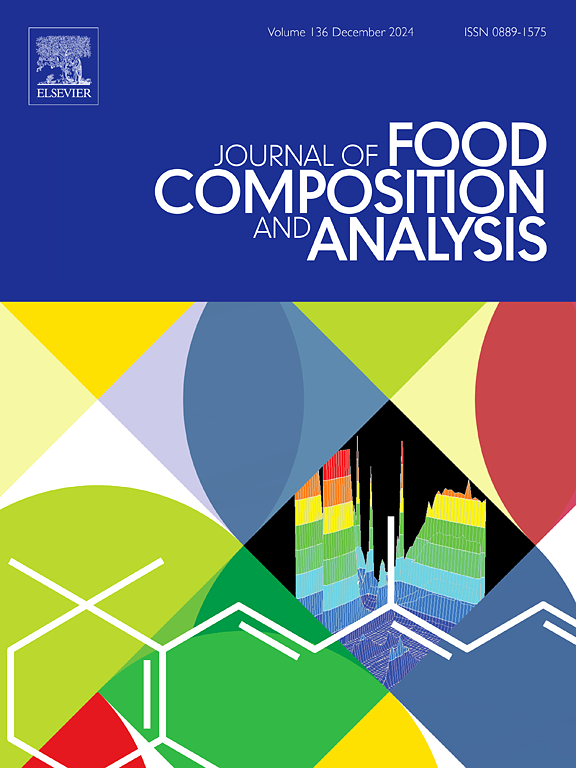Effect of Zataria multiflora essential oil, saffron infusion, and fat content on the formation of polycyclic aromatic hydrocarbons, organoleptic score, and toxic potency of Kebab Koobideh
IF 4
2区 农林科学
Q2 CHEMISTRY, APPLIED
引用次数: 0
Abstract
Kebab Koobideh ranks among the most popular in Iran, Turkey, and other countries. This product is prepared by mixing minced meat, onion, and various spices. The objective of our study was to examine the influence of Zataria multiflora essential oil (ZMEO), fat, and saffron infusion as independent variables on the formation of four polycyclic aromatic hydrocarbons (PAH4) and sensory attributes of Kebab Koobideh. The findings indicated that all independent variables exerted a significant impact on the formation of ∑PAH4. Zataria multiflora essential oil was observed to exert an inhibitory effect on the production of ∑PAH4. The saffron infusion demonstrated a reduction in impact at lower concentrations, while increased effectiveness was observed at higher concentrations. Additionally, a sample meeting the desired specifications, containing 18.5 % fat, 0.008 % saffron infusion, and 0.02 % ZMEO, was prepared with consideration of two dependent responses. The desirability of this sample was quantified at 0.72. The sample contained 2.20 ng g−1 of ∑PAH4 and was rated as acceptable by sensory analysis, with a score of 84.60 out of 100. All samples exhibited a margin of exposure (MOE) exceeding 100,000, indicating that there is minimal cause for concern. The incremental lifetime cancer risk (ILCR) for the samples with 10 % fat, 0.05 % saffron infusion, and 0.02 % ZMEO, as well as for the sample with 10 % fat, 0 % saffron infusion, and 0.01 % ZMEO, was found to be negligible. The assessment of overall quality is contingent upon the evaluation of fat content. In conclusion, the integration of effective variables can result in a sample that exhibits satisfactory organoleptic characteristics while simultaneously reducing the concentration of PAHs.
红花挥发油和脂肪含量对多环芳烃形成、感官评分和毒力的影响
烤肉串在伊朗、土耳其和其他国家都是最受欢迎的。该产品由肉末、洋葱和各种香料混合而成。本研究以扎扎叶挥发油(ZMEO)、脂肪和藏红花为自变量,考察其对四种多环芳烃(PAH4)的形成和对烤肉感官属性的影响。结果表明,各自变量对∑PAH4的形成均有显著影响。多连挥发油对∑PAH4的产生有抑制作用。在较低的浓度下,藏红花输注的影响减少,而在较高的浓度下,效果增加。此外,考虑到两种依赖反应,制备了符合所需规格的样品,其中含有18.5 %脂肪,0.008 %藏红花灌注和0.02 % ZMEO。该样本的可取性被量化为0.72。样品的∑PAH4含量为2.20 ng g−1,感官分析为可接受,得分为84.60分(满分100分)。所有样品的暴露裕度(MOE)均超过100,000,表明需要关注的原因微乎其微。研究发现,脂肪含量为10% %、藏红花输注量为0.05 %、ZMEO含量为0.02 %的样品,以及脂肪含量为10% %、藏红花输注量为0 %、ZMEO含量为0.01 %的样品的增量终生癌症风险(ILCR)可以忽略不计。对整体质量的评估取决于对脂肪含量的评估。综上所述,有效变量的整合可以使样品具有令人满意的感官特性,同时降低多环芳烃的浓度。
本文章由计算机程序翻译,如有差异,请以英文原文为准。
求助全文
约1分钟内获得全文
求助全文
来源期刊

Journal of Food Composition and Analysis
工程技术-食品科技
CiteScore
6.20
自引率
11.60%
发文量
601
审稿时长
53 days
期刊介绍:
The Journal of Food Composition and Analysis publishes manuscripts on scientific aspects of data on the chemical composition of human foods, with particular emphasis on actual data on composition of foods; analytical methods; studies on the manipulation, storage, distribution and use of food composition data; and studies on the statistics, use and distribution of such data and data systems. The Journal''s basis is nutrient composition, with increasing emphasis on bioactive non-nutrient and anti-nutrient components. Papers must provide sufficient description of the food samples, analytical methods, quality control procedures and statistical treatments of the data to permit the end users of the food composition data to evaluate the appropriateness of such data in their projects.
The Journal does not publish papers on: microbiological compounds; sensory quality; aromatics/volatiles in food and wine; essential oils; organoleptic characteristics of food; physical properties; or clinical papers and pharmacology-related papers.
 求助内容:
求助内容: 应助结果提醒方式:
应助结果提醒方式:


